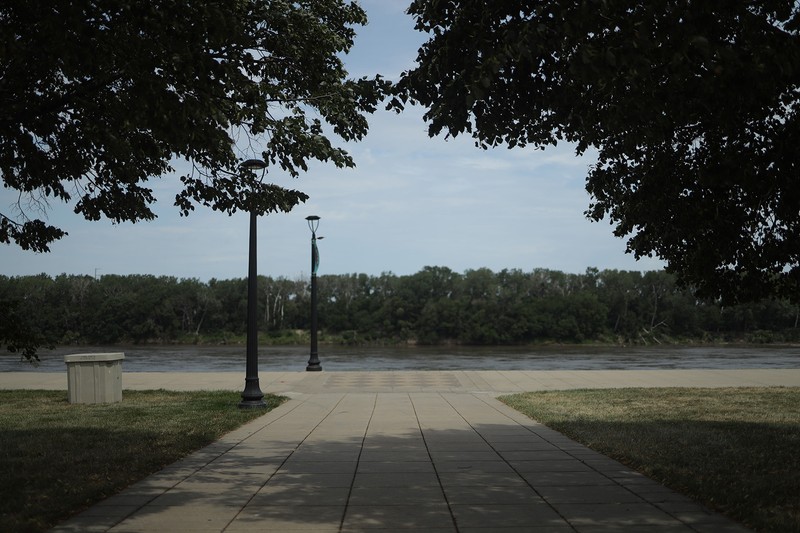KC Streetcar Riverfront Stop
Introduction
Author-Uploaded Audio
Listen to a narration of this entry's description by JCHS.
Text-to-speech Audio
Welcome to the Jackson County Historical Society’s walking tour of Kansas City’s historic riverfront. Here the streetcar line begins at the base of Grand Avenue. Looking north to the river is the original rocky ledge landing that was called Westport Landing. Here between 1837 and 1865 steamboats would pull up to the levee and offload the people and goods heading westward overland on the Santa Fe, California, and Oregon Trails. The starting point of this combined trail system of more than 5000 miles, was the town of Westport, three miles to the south of this point. (For more on the period, read the historic markers located along Riverfront Park beginning in front of you at the station.)
Images

Backstory and Context
Author-Uploaded Audio
Listen to a narration of this entry's description by JCHS.
Text-to-speech Audio
Prior to 1837, Independence, Missouri - twelve miles downriver, or east, of Westport Landing - was the principal jumping off point of the trails. However, in that year, when the Westport Landing was begun by some enterprising young entrepreneurs, Independence would be supplanted. This was because the Westport Landing and the town of Westport made the access to the trailheads closer and now cheaper to ship people and cargo. From then on, the Westport Landing, to later be referred to as the Town of Kansas, along with the town of Westport were the destination of the hundreds of thousands looking for new life and riches in the American west. It was the coming of the railroad that would end the thirty-year boom period of this overland trail system, and largely the topic of this presentation.
By 1860 federal surveyors had mapped five rail routes to the Pacific for consideration by the Congress and the president. President Lincoln chose a route from Omaha, Nebraska for the first rail line to reach the West Coast. At the time Kansas City had no real rail access lines and the lack of a bridge across the Missouri blocked its path forward for any real consideration.
Thomas Hart Benton, a U.S. senator for Missouri and granduncle to the painter of the same name would say,
“America’s destiny hinges on building a railroad out where steamboats can not go. Immigrants would flock upon it as pigeons to the roosts, tear open the bosom of the virgin soil and spring into existence the long line of farms, homes, towns, and villages, of orchards, field, or churches…to the Pacific.”
For Kansas City to realize its piece of this vision, and to go from a squalid river town into a major commercial center, came down to two words – The Bridge.
Kansas City exited the Civil War in 1865 as a divided and bloodied community of a few thousand people. Just a year before the North and South clashed here in the largest engagement west of the Mississippi leaving thousands of dead and wounded. For years to come Unionists would live off Main Street on avenues named Pennsylvania, Broadway, and Washington. Southerners favored roads east with signs of Oak, Walnut and Locust. The streets were muddy morasses beaten down by hooves of mules and wagons with the air reeking of garbage and manure. Observed one visitor,
“The streets crossed at angles as regular as zig-zag lightning chasing amatory tomcats. Sidewalks were dusty planks so slippery after a drizzle that folks stepped along with arms outstretched, like tightrope artist. Red shirts, bowie knives and pistols openly worn were everywhere among the countless saloons and brothels.”
Despite the look and smell of the place civic boosters like John Calvin McCoy, Kersey Coates and Robert Van Horn continued to urge the eastern venture capitalist and government to look past the filth of the place and see its future potential. Van Horn moved to Kansas City from Ohio in 1855 and bought a newspaper from which he shouted about the town’s bright prospects. In one of his first columns he wrote,
“Kansas City is by the laws of God and physical geography the great commercial port of the plains ….and nothing but a disruption of nature can stay her destiny.”
Van Horn and the other civic boosters including Charles E. Kearney and lawyer John W. Reid, made the first bridge and rail crossing across Missouri their number one priority. Through their lobbying and cajoling by 1865 Kansas City could claim a few rail routes on the river’s south bank. The Kansas Pacific stretched west to Topeka where work was just beginning to connect with the cattle drives coming up from Texas. This would later be the heart of the city’s meat packing industry in the West Bottoms.
Sources
Little, Leigh Ann. Olinskey, John M.. Images of America: Early Kansas City, Missouri. Arcadia Publishing, 2013.
Jackson, David W. Kansas City Chronicles: An Up-to-Date History. The History Press, 2010.
Kansas City Missouri: Its History and its People 1808 - 1908. Volume 1. S.J. Clarke Publishing, 1908.
Mathews, Bruse. Noll, Steve. Mackle, Lynn, editor. Kansas City: Our Collective Memories. DGHFKC Books, LLC, 2016.
Foote, Shelby. The Civil War Fredericksburg to Meridian,. Edition Vintage Book Edition. 1963.
